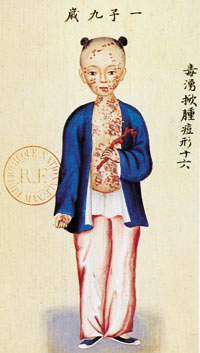| |
|
by Richard Levin, professor of biology
 |
Chinese
girl suffering from smallpox: watercolor
(Images
provided by the Granger Collection)
|
"All
things are delicately interconnected," goes an old adage,words
that have been elegantly acknowledged in story and verse throughout
history. Now, in the most unlikely of arenas, the timeliness
of this observation is striking. The threads that bind disconnected
events threaten to turn one of our greatest public health
accomplishments, namely, the elimination of smallpox, into
a potential vehicle for a tragedy of worldwide proportions.
It was the eighth of May, 1980, and you could almost
hear the champagne corks popping in virus laboratories all
over the world. On that day the World Health Organization
(WHO) accepted the final report of the Global Commission for
the Certification of Smallpox Eradication that declared the
world cleansed of smallpox. TheWHO declaration was not areckless
claim. With the exception of one smallpox death in 1978, the
result of a bizarre laboratory accident, the last known case
was reported in Somalia in 1977. After an appropriately cautious
three-year delay, the jubilant announcement seemed fully justified,
and we felt free of the disease that has been described as
the most terrible of all the ministers of death. Two decades
have since elapsed, and smallpox has never reappeared.
Some
parts of the story are well known. Of all of the infectious
killers in history, smallpox ranks number one. As a mortal
enemy it has surpassed malaria, tuberculosis, amoebic dysentery,
measles, epidemic typhus, bubonic plague, cholera, typhoid,
sleeping sickness, and influenza. In our own time, the toll
of AIDS, which we have known for only 19 years, has yet to
be reckoned with and will likely compete for the top rung
of that deadly ladder. These infectious diseases and others
are the handiwork of the greatest microbial assassins of all
time.
In 1953
one discovery changed the course of biology. The structure
of DNA was revealed and the floodgates of inquiry burst open.
Questions that could never be addressed before were now amenable
to investigation. Certainly this was among the most important
scientific achievements of all time. As the new, sophisticated
molecular biology developed, scientists quickly took advantage
of the new molecular insights and technological advances.
Microbiology, virology, immunology, genetics, and the molecular
biology of infectious disease were among the fields in which
the pace of progress was stunning. It seemed that we might
even be able to look forward to a time when some of the deadliest
diseases could be controlled.
Curing
certain bacterial diseases had been a tantalizing priority
since the 1940s, when penicillin, streptomycin, and a veritable
zoo of other antibiotics were introduced as therapeutic
drugs that killed or inhibited disease-producing bacteria.
Expectations rose that syphilis, bubonic plague, tuberculosis,
and cholera would eventually succumb to these potent new
drugs, but those presumptions have never been realized.
Bacteria mutate to antibiotic resistance so easily that
not a single bacterial disease has been eliminated, and
it appears unlikely that our powerful antibiotics will ever
wipe out all traces of these old enemies.
But
smallpox was another story. It was not the action of
virus-destroying chemicals that contained and finally conquered
the disease; it was the laborious effort of the Smallpox
Eradication Unit of the World Health Organization. Teams
of workers, led by Oberlin graduate Donald A. Henderson
'50, scoured the globe from 1966 to 1977, poking into every
village on earth until there were no cases reported anywhere
in the world. Their methods were the tried-and-true public
health techniques of mass vaccinations of the uninfected
and a rigorous quarantine of those who were sick.
next
page
|